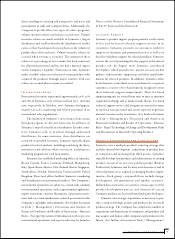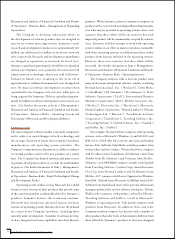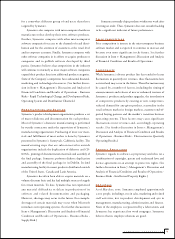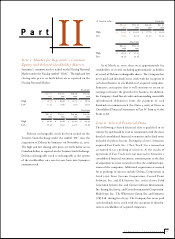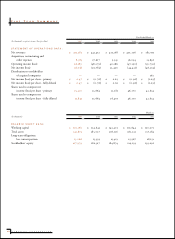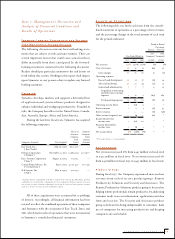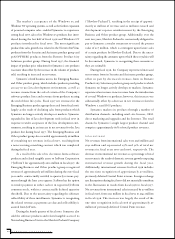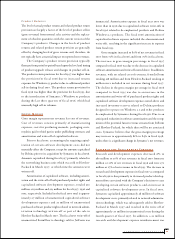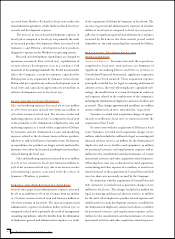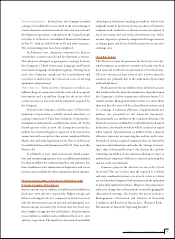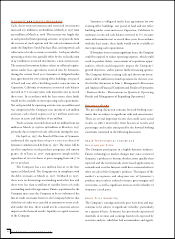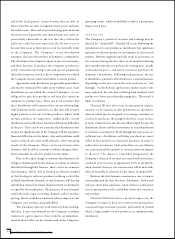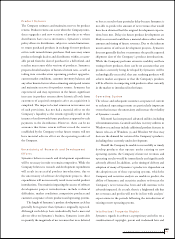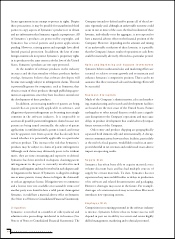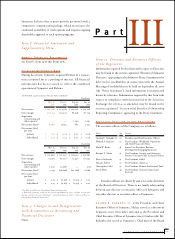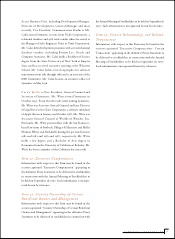Symantec 1997 Annual Report Download - page 25
Download and view the complete annual report
Please find page 25 of the 1997 Symantec annual report below. You can navigate through the pages in the report by either clicking on the pages listed below, or by using the keyword search tool below to find specific information within the annual report.
Restructuring Expenses In fiscal 1997, the Company recorded
a charge of $3 million for costs related to the restructuring of
certain domestic and international sales and research and
development operations, settlement of the Carmel lawsuit
(see Note 11 of Notes to Consolidated Financial Statements
in Part IV, Item 14 of this Form 10-K) and other expenses.
The restructuring plans have been completed.
In February 1995, Symantec announced a plan to
consolidate certain research and development activities.
This plan was designed to gain greater synergy between
the Company’s Third Generation Language and Fourth
Generation Language development groups. During fiscal
1996, the Company completed the consolidation and
recorded $2 million for the relocation costs of moving
equipment and personnel.
Other Expenses In fiscal 1997, Symantec recorded a $2
million charge in connection with the write-off of an equity
investment and a $3 million charge for the write-off of
certain in-process research and development acquired by
the Company.
In fiscal 1996, Symantec sold the assets of Time Line
Solutions Corporation, a wholly-owned subsidiary, to
a group comprised of Time Line Solutions Corporation’s
management and incurred a $3 million loss on the sale. In the
fourth quarter of fiscal 1996, the Company recorded $2
million for estimated legal fees expected to be incurred in
connection with a securities class action complaint filed in
March 1996 and other legal matters (See Note 11 of Notes to
Consolidated Financial Statements in Part IV, Item 14 of this
Form 10-K).
As of March 31, 1997, total accrued cash related acquisi-
tion and restructuring expenses were $4 million and included
less than $1 million for estimated legal fees and expenses, less
than $1 million for the elimination of duplicative and excess
facilities and $3 million for other acquisition related expenses.
Interest Income, Interest Expense and
Other Income (Expense)
Interest income was $7 million, $8 million and $6 million in
fiscal 1997, 1996 and 1995, respectively. Higher average cash
balances during fiscal 1997 compared to fiscal 1996 were
offset by lower interest rates on invested cash during the year.
Interest income increased 33% in fiscal 1996 over fiscal 1995
due to higher average invested cash balances. Interest expense
was $1 million, $2 million and $2 million in fiscal 1997, 1996
and 1995, respectively. The April 1995 conversion of convertible
subordinated debentures totaling $10 million, which were
originally issued in April 1993, for 833,333 shares of Symantec
common stock, resulted in a reduction in interest expense in
fiscal 1997 from 1996 and in fiscal 1996 from 1995. Other
income (expense) is primarily comprised of foreign currency
exchange gains and losses from fluctuations in currency
exchange rates.
Income Taxes
The effective income tax provision for fiscal 1997 was 14%,
which compares to an effective income tax benefit of 10% in
fiscal 1996 and an effective tax provision of 25% in fiscal 1995.
The 1997 income tax provision of 14% is lower than the
statutory rate primarily due to the utilization of previously
unbenefitted losses.
Realization of the $13 million of net deferred tax asset
that is reflected in the financial statements is dependent upon
the Company’s ability to generate sufficient future U.S.
taxable income. Management believes that it is more likely
than not that the asset will be realized based on forecasted
U.S. earnings. A valuation allowance of approximately $40
million was provided in the financial statements.
Approximately $22 million of the valuation allowance for
deferred tax assets is attributable to unbenefitted stock option
deductions, the benefit of which will be credited to equity
when realized. Approximately $4 million of the valuation
allowance represents net operating loss and tax credit carry-
forwards of various acquired companies that are limited by
separate return limitations and under the “change of owner-
ship” rules of Internal Revenue Code Section 382, and the
remaining $14 million of the valuation allowance relates to
unbenefitted temporary differences and net operating loss
and tax credit carryforwards.
Symantec projects the effective tax rate to be 23% in
fiscal 1998. This rate is lower than the expected U.S. federal
and state combined statutory rate of 40% is due to a lower
tax rate from the Company’s Irish operation and the utilization
of previously unbenefitted losses. However, this projection is
subject to change due to fluctuations in and the geographic
allocation of earnings. (See further discussion in Item 7:
Management’s Discussion and Analysis of Financial
Condition and Results of Operations - Business Risks -
Fluctuations in Quarterly Operating Results.)
23
SYMANTEC CORPORATION


